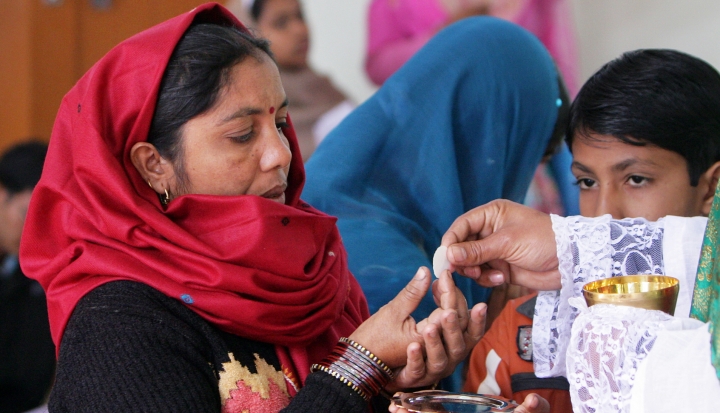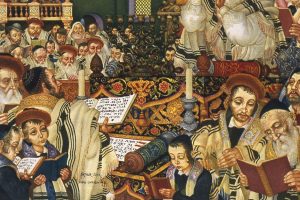Catholic Dalits (untouchables) in India are divided over how to improve their lot.
Franklin Caesar Thomas and R. L. Francis both attend Mass at Sacred Heart Cathedral in New Delhi. Though the two lay activists with similar backgrounds may be polite on Sundays, they don’t like each other.
Like 70 percent of Catholics in India, Thomas and Francis are Dalits—untouchables. For thousands of years, Indian society has been structured by caste, divided into four main groups and thousands of sub-groups. A family’s caste still largely determines one’s social standing and opportunities, and Dalits fall at the bottom.
Untouchability—the idea that coming into contact with a Dalit would make an upper-caste individual impure—was made illegal in India’s 1959 Constitution. However, discrimination and segregation continue in many parts of India, and efforts to correct the inequalities continue to spark debate, including within the church. Caste is so embedded in Indian culture that it has seeped into every religion in the country.
Today Thomas and Francis may sit next to upper-caste Christians in Delhi’s cathedral, but only decades ago a Southern Indian church built a wall down its middle so that castes could worship at the same time without seeing each other. Many churches had separate vessels for communion.
Caste also affects educational and economic opportunities. As a fourth-generation Catholic and son of a teacher, Thomas was relatively well off. Still, his family didn’t have electricity until 1995. “If this is the life of the son of a teacher, what about our neighbors?” he asks.
His neighbors are more like Francis, who didn’t have access to the church’s excellent schools. Francis attended a government school through the seventh grade. “Like Jesus, never got any study,” he says with a laugh in halting English. As the language of business, English is essential to get ahead in India, but Dalit children still rarely have access to an English education.
Both Thomas and Francis want to give Dalits greater opportunities to succeed. A pending case in India’s Supreme Court, however, divides the two Catholics. Thomas, working with the church, brought a lawsuit to help Christian Dalits gain access to government benefits. Francis, on the other hand, wants the church to take care of its own.
A government commission in 2007 reported that denying to Christian and Muslim Dalits benefits that Dalits of other faiths receive violated the Constitution, although the Supreme Court has deferred a ruling several times. Last August supportive bishops, priests, and nuns joined a protest march in New Delhi, urging the court to finally issue its ruling.
The case, however, is about more than the classic debate between government and private charity. It also represents the struggle of the church to address social structures: Should Christians deal with caste, class, and racial divides practically or prophetically?
“One encounters that anywhere when one works in the developing world,” says Michael La Civita, vice president of communications for the Catholic Near East Welfare Association (CNEWA). “One has to be respectful of social structures but one can’t compromise the gospel, either.”
Government solutions
Thomas, a large man in a country where poverty is visible in the stringy arms and legs of bicycle rickshaw drivers, didn’t need government benefits. He was educated as an engineer and got a job in recruiting at Indian Railways despite being a Dalit.
But at work he noticed that he was luckier than most Dalit Christians. “With my own eyes I saw how Dalit Christian applications were rejected,” he says.
Hindu Dalits, meanwhile, got coveted government jobs through the “reservation” system. Like affirmative action, the system aims to correct past discrimination by giving previously excluded groups access to greater opportunities. As outlined in the Constitution, India holds spots for Dalits in government posts, schools, and political bodies.
Only Hindus, Buddhists, and Sikhs have access to these spots. Christianity and Islam—“foreign religions”—preach equality and therefore do not have caste. The ideals of Christianity, though, do not match the experiences of Christian Dalits.
Missionaries historically conformed to caste rules, says Father G. Cosmon Arokiaraj, who until last June served as executive secretary of the Office of Scheduled Castes and Backward Classes for the Catholic Bishops’ Conference of India. “They didn’t see it as diametrically opposed to the Christian faith,” he says. Winning souls was more important than opposing caste.
Thanks to the tradition of missionary schools, Dalit Christians are slightly better educated than other Dalits, but sociological research shows their economic status to be similarly dismal. Most importantly for the church, economic disparities between Dalits and the upper caste are higher among Christians than in any other religious community.
In the northeastern countryside of the state of Uttar Pradesh, the Dalit Catholics of St. Francis Parish in Swar continue to struggle. In one of India’s poorest areas, 33-year-old Savriti is one of the estimated 1.3 million Dalits who are still forced to work as “manual scavengers,” removing human excrement. Every day Savriti cleans out the dry latrines of 60 families in several different villages. Although illegal since 1993, the practice continues throughout India.
“I started this work when I got married,” Savriti told the international Catholic mission magazine Kontinente. “There is no other way for us to make a living. … When we take a break, we are not allowed to sit on a stool, only on the floor. We’re not allowed to touch the water pump. When we ask for water, they pour it into our hands.”
She works all day without eating, but the worst part, she says, is the shame. “When someone sees me working, I am very ashamed. I don’t really like to talk about these things. I pray that I will find a different kind of work.”
Savriti is a member of St. Francis Parish, and a group of sisters of the Clarist Franciscan Missionaries of the Most Blessed Sacrament have helped her build a solid house, provided medicine for her husband’s heart ailments, and enrolled her children in a Catholic school.
Though the separate cemeteries, chalices, and pews may be history in India’s Catholic parishes today, an invisible form of discrimination continues, says Arokiaraj, who as a Dalit priest has had to struggle to gain the acceptance of upper-caste parishioners.
Even though Dalits make up 70 percent of the church, only 600 of India’s 17,000 priests and six of the 160 bishops come from the Dalit community.
When Thomas saw the discrimination at Indian Railways, therefore, he didn’t think to go to the church. “The church will not … fulfill our needs. They don’t have the mindset,” he says. “We are not in the power structure.”
Instead, Thomas challenged the government, arguing that restricting scheduled caste benefits to Hindus, Buddhists, and Sikhs was unconstitutional. With the help of a prominent public interest litigator, he brought a lawsuit to the Supreme Court in 2004 in hopes of getting rid of the religious qualification for the reservation system.
Despite Thomas’ doubts about the church, when he told the Catholic bishops’ conference and the Protestant organizational body about the lawsuit, both lent their support and helped Thomas form the National Council of Dalit Christians. [Thomas clarifies that he only receives moral support from Catholic and Protestant churches, not financial support.]
The case is clearly religious discrimination, says lawyer Prashant Bhusan, but public interest litigation often takes years. Thomas and his allies are confident the case will be decided in their favor—and soon. Politics have delayed a decision, Thomas says.
Don’t call me Dalit
Though also a Catholic Dalit, R. L. Francis is among the opponents trying to derail Thomas’ case. The problem with Thomas’ approach, Francis says, is evident in the name of his organization. “We converted to Christianity in the hopes that we would get self-respect, dignity, and equality. Why are they calling us Dalit, Dalit, Dalit? We are Christian only,” he says.
Francis’ organization, the Poor Christian Liberation Movement, intentionally avoids the term “Dalit Christian” because caste is not a part of Christianity.
If Christians gained government benefits, they would have to register with the government as Dalits. “They want to fix the stigma of Dalit on our forehead,” Francis says.
The reservation system has solidified Dalit identity among Hindus. Dalit political parties are strong, but this isn’t always good, says Rajiv Malhotra, the U.S.-based author of Breaking India (Amaryllis), a critical analysis of the Dalit identity. Identity politics create tensions between communities as groups fight for limited resources.
“Once affirmative action is based on caste, then caste becomes a tool,” Malhotra says. Extending the reservation system to non-Hindus “will perpetuate the caste system against them even worse.”
With access to reservations, Francis might have been able to continue his education past seventh grade. But he would rather see his daughter earn a spot in a Catholic school than in a government school.
For that, the church needs an internal reservation system, he says. It could direct financial resources, jobs, and seats in its top-ranked schools to the poor.
The Bible “says everybody is equal in the name of Jesus Christ,” Francis says, but the church doesn’t live up to this standard of equality. Worse, Francis thinks Indian churches have joined Thomas’ cause so they can gain access to government resources instead of directing their own resources to the poor. It’s about money, he says.
Conversion politics
Millions of dollars flow from the United States and Europe into Dalit ministries—particularly from evangelical churches. “It’s a total money-making program of the church from U.S., European countries,” Francis says.
The more people the church converts, the more money it can raise overseas. There are doubts about whether those funds make it to the poor, but the promise of financial support can lure converts. Hindu nationalists, who work for an India united by Hindu culture, feel threatened by conversion. Access to government reservations would give Hindus more incentive to convert, they worry.
While he lauds the Christian message of equality, Francis worries that Hindu Dalits are converting for the wrong reason. The church should take better care of its own before reaching out to non-Christians, he says.
Thomas, on the other hand, thinks the church loses people because of the religious discrimination in the reservation system. Some Christian Dalits have “reconverted” to Hinduism, at least officially, to regain the government benefits.
Even if Hindus convert for material support, it’s a good thing, Thomas says. “I’m very particular: One religion calls all these people as illegitimate children; the other religion calls these people as sons and daughters of God.”
The debate is not unique to India. The church always struggles with the question of whether people convert for material or spiritual sustenance, La Civita of CNEWA says.
Whether it be caste, class, race, tribe, or gender, the church encounters social injustices all around the world. Interracial marriages were once as unthinkable in the United States as intercaste marriages are today in India. The challenge for the church is to walk the fine line between working within and challenging such structures.
“One can say that the reason that these churches even exist is because of the social outreach,” La Civita says. On the other hand, the Catholic way of dealing with inequality and poverty is not “handing people a bowl of rice and baptizing them.”
Instead, sisters, priests, and laypeople build the church over time by demonstrating the message of Christianity through their work. “These are relationships that are being developed and nurtured for years,” La Civita says.
Even after the Supreme Court makes its decision, it will take years to determine whether the case will result in greater conversions or simply in corruption; in the uplifting of Christian Dalits or in the codifying of their status as Dalits.
There may be no perfect solution, but Arokiaraj, the Dalit priest who worked for the bishops, says that to create a society in which there is no caste, both the church and government need to do more than just say Dalits are equal. “Mere preaching won’t do,” he says.
Preaching, however, is all he can do while waiting for a Supreme Court decision. On Dalit Liberation Sunday, held in December each year, Arokiaraj says Mass at Sacred Heart Cathedral. Thomas, Francis, and Catholics of all castes listen from the pews to prayers that push them to acknowledge the sinfulness of caste and do something to change it.
“As followers of your beloved son Jesus, we have failed to challenge attitudes, practices, and structures that are contrary to the values of equality, justice, and freedom that are integral to the gospel of Christ our Savior,” one prayer reads. “Through your abiding presence, give us the courage to persevere in our struggles for equal rights.”
This article appeared in the March 2013 issue of U.S. Catholic (Vol. 78, No. 3, pages 23-27).
Image: Friedrich Stark














Add comment